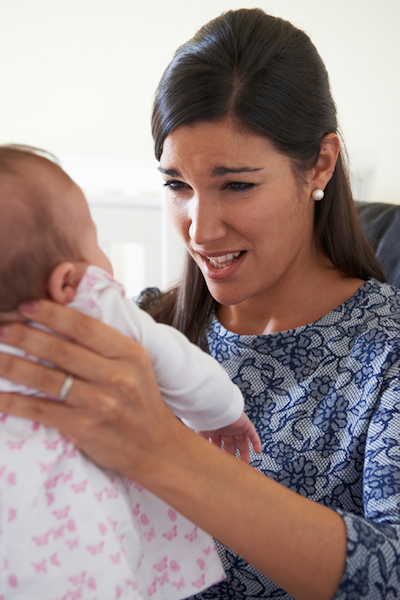Shaken baby syndrome: A severe and disheartening form of child abuse
What parent hasn’t felt frustration and helplessness when unable to console their crying infant? Despite being stressed, something deep inside prevents us from inflicting harm to our children. Unfortunately, this impulse control is not present in some parents or caregivers, resulting in a child being vigorously shaken.
What is shaken baby syndrome?
 This violent shaking of an infant or young child is a severe form of child abuse, and is commonly known as Shaken Baby Syndrome (SBS). Pediatricians and other physicians are beginning to use the more general term of “abusive head trauma” when describing an inflicted injury to the head of a child. Violent shaking of a child with or without impact can result in a wide spectrum of symptoms due to the brain damage it causes. Children often have additional injuries such as fractures, bruises, and hemorrhages to the back of the eyes when violently shaken.Upwards of 1,300 children a year are severely injured, or die from inflicted head trauma. However, this statistic largely underestimates the problem of shaking a child, since it only identifies the children whose injuries were serious enough to require hospitalization. In severe cases, children have immediate loss of consciousness, difficulty breathing, seizures, pale or blue color, and are floppy “like a rag doll.” In milder cases of shaken baby syndrome, the infant may show signs of more general symptoms such as: irritability, crying, vomiting, or poor feeding. They may not require medical attention, as the symptoms often resolve on their own without medical treatment.
This violent shaking of an infant or young child is a severe form of child abuse, and is commonly known as Shaken Baby Syndrome (SBS). Pediatricians and other physicians are beginning to use the more general term of “abusive head trauma” when describing an inflicted injury to the head of a child. Violent shaking of a child with or without impact can result in a wide spectrum of symptoms due to the brain damage it causes. Children often have additional injuries such as fractures, bruises, and hemorrhages to the back of the eyes when violently shaken.Upwards of 1,300 children a year are severely injured, or die from inflicted head trauma. However, this statistic largely underestimates the problem of shaking a child, since it only identifies the children whose injuries were serious enough to require hospitalization. In severe cases, children have immediate loss of consciousness, difficulty breathing, seizures, pale or blue color, and are floppy “like a rag doll.” In milder cases of shaken baby syndrome, the infant may show signs of more general symptoms such as: irritability, crying, vomiting, or poor feeding. They may not require medical attention, as the symptoms often resolve on their own without medical treatment.
Even if a child is seen by a physician, upwards of 30% many not be diagnosed as shaken baby syndrome because of the general complaints of a young child with a head injury. Unfortunately in milder cases, a physician would not get a truthful history from the caregiver, and can easily misdiagnose the child as having a viral illness, ear infection, stomach flu, or colic.
What are the risk factors?
The factors that may increase the risk of parents shaking their baby include: a parent having unrealistic expectations of their baby, poverty, being a young parent, being a single parent, and a history of abuse as a child. Stress within the family including domestic violence, substance abuse, absent support system, and financial issues can also increase the incidence of physical abuse. Male children are at a higher risk for shaken baby syndrome, and being cared for by an unrelated male increases the child’s risk as well.The devastating effects of shaken baby syndrome
Unfortunately, shaking an infant is a type of child abuse that is actually effective. The child stops crying due to the concussion symptoms from the brain injury, a result of the violent acceleration/deceleration of the brain that is injured as it moves within the skull. Without the intervention of programs, such as the Child Protection Team at the Howard Phillips Center for Children & Families, the children are often repeatedly shaken over time, resulting in additional brain injuries.Just a few seconds of violent shaking can result in irreversible brain injury, or even death. The degree of injury is related to the force and duration of the shaking. Impact of the head, even onto a soft surface such as a mattress, will tremendously increase the severity of the brain injury. About 25-40% of hospitalized children die from being shaken, and the survivors often require lifelong medical care from conditions such as blindness, seizure activity, or cerebral palsy. In milder cases, the children may appear normal when discharged from the hospital but over time, many of these children develop learning and behavioral problems.
Shaken baby syndrome is 100% preventable if we can find a way to alleviate the stress of the parent or caregiver when a baby is crying inconsolably. So, what can we do?
- Inform others about hospital based programs that teach new parents about the dangers of shaking their infant and how to respond when their baby cries.
- Inform new parents about prevention programs, such as the Period of Purple Crying, to better help parents understand why babies cry.
- Provide recommendations for books on how to reduce infant crying, such as those written by Dr. Harvey Karp.
- Make sure that the other people who help take care of your baby including friends, babysitters, siblings, and grandparents know about the dangers of shaken baby syndrome.
- Help new parents find support through counseling or parenting classes.
- And most importantly, if you find yourself becoming annoyed or angry with your baby, realize that it is not your fault that he is crying, and that it is okay to put him in his crib and leave the room. Call someone for support who is able to intervene if you are feeling out of control.






